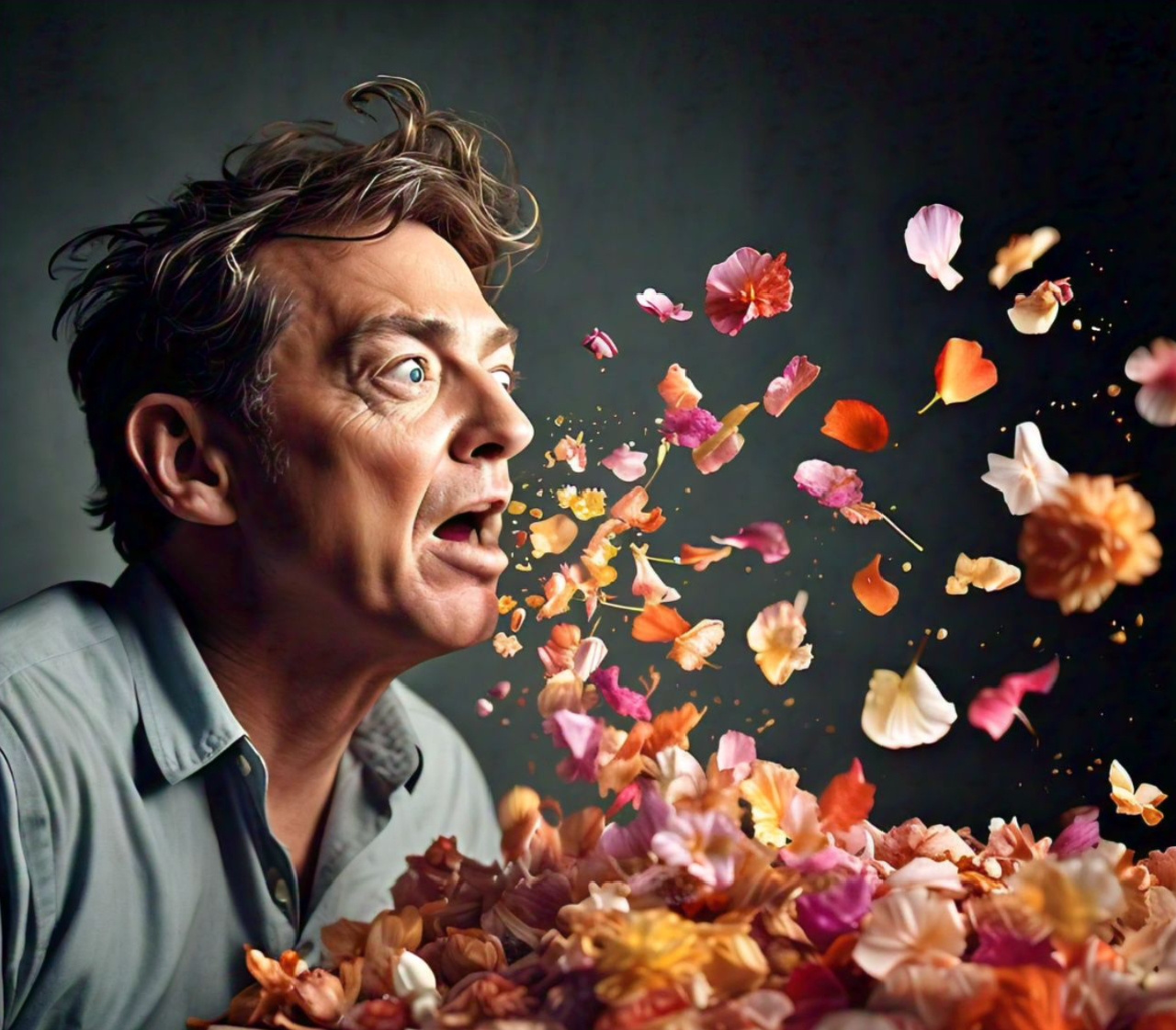Hanahaki disease is a fictional condition often explored in literature and art, characterized by the physical manifestation of flowers growing within the lungs or respiratory tract of a person in unrequited love. While it exists solely in the realm of imagination, its popularity reflects a deep-seated fascination with the intersection of emotions and physical health.
Understanding Hanahaki Disease
Hanahaki disease is a romanticized concept originating from Japanese fiction, particularly in anime and manga. It symbolizes the agony of unrequited love, where the afflicted person experiences severe coughing fits that expel flower petals and, in some versions, actual flowers. The severity of symptoms varies widely in different portrayals, ranging from mild discomfort to life-threatening respiratory obstruction.
Symptoms of Hanahaki Disease
The symptoms of Hanahaki disease typically begin subtly, with the person experiencing occasional coughing fits. These fits become more frequent and severe over time, often accompanied by the expectoration of flower petals or blooms. The type and color of flowers expelled can vary depending on the individual’s emotions and the nature of their unrequited love. Some stories depict the petals as harmless and merely symbolic, while others suggest they can cause physical harm, such as obstructing airways.
As the disease progresses, respiratory symptoms may worsen, leading to shortness of breath, chest pain, and fatigue. In extreme cases, complications such as pneumonia or respiratory failure may develop, adding to the dramatic portrayal of the disease in fiction.
Causes of Hanahaki Disease
The underlying cause of Hanahaki disease lies in the emotional turmoil of unrequited love. When a person loves someone deeply but their feelings are not reciprocated, it can trigger a profound psychological and physiological response. In the context of the disease, this emotional distress manifests physically, causing the growth of flowers within the respiratory system.
The exact mechanism of how emotions trigger such a physical response remains a mystery, as Hanahaki disease is purely fictional. However, it serves as a poignant metaphor for the profound impact of unrequited love on both mental and physical well-being.
Cure for Hanahaki Disease
In fictional portrayals, the cure for Hanahaki disease often involves two primary approaches: resolving the unrequited love or undergoing surgery to remove the flowers. Resolving the love typically means the afflicted person’s feelings are reciprocated, allowing the flowers to naturally wither away. Surgery, on the other hand, involves a risky procedure where the flowers are physically removed from the lungs, often resulting in the loss of the person’s romantic feelings as well.
In more recent adaptations and interpretations, some stories explore alternative treatments or magical cures that alleviate symptoms without requiring the cessation of love or invasive procedures. These variations highlight the evolving nature of the disease as a narrative device and its adaptability to different cultural and creative contexts.
Cultural Impact and Adaptations
Hanahaki disease has gained significant popularity within fan communities and literary circles, inspiring numerous adaptations and interpretations across different media. Its enduring appeal lies in its ability to evoke empathy and fascination with themes of love, sacrifice, and the human condition.
In anime and manga, Hanahaki disease often serves as a dramatic plot device, exploring complex emotions and relationships through the lens of speculative fiction. Writers and artists continue to reimagine and reinterpret the disease, infusing it with new meanings and symbolism that resonate with contemporary audiences.
Certainly! Here are 4 to 5 additional points with more details about Hanahaki disease:
Additional Points About Hanahaki Disease
- Symbolism and Flowers: The flowers that manifest in Hanahaki disease are often symbolic, representing not only the type of love the afflicted person feels but also the emotions associated with it. For example, red roses might symbolize passionate love, while forget-me-nots could represent longing and nostalgia. The choice of flowers adds layers of meaning to the narrative, enhancing the emotional impact of the disease.
- Psychological Impact: Beyond its physical symptoms, Hanahaki disease explores the profound psychological impact of unrequited love. The constant struggle between longing and despair can lead to anxiety, depression, and a sense of hopelessness in the afflicted individual. This psychological dimension enriches the storytelling aspect of the disease, highlighting its relevance in exploring complex human emotions.
- Cultural Variations: While Hanahaki disease originated in Japanese fiction, similar concepts exist in other cultures under different names and interpretations. For instance, in Western literature, themes of consuming passion and unrequited love are often explored through metaphors involving hearts or other organs. These variations reflect cultural differences in how emotions and physical health are perceived and portrayed in storytelling.
- Medical Misconceptions: Despite its popularity in fiction, Hanahaki disease has no basis in medical science. The growth of flowers within the lungs or respiratory system is purely fantastical and does not correspond to any known medical condition. However, its imaginative portrayal continues to captivate audiences and inspire creative works exploring themes of love and sacrifice.
- Fan Interpretations and Fanfiction: Hanahaki disease has sparked a vibrant community of fans who create fan art, fanfiction, and other derivative works based on the concept. These interpretations often diverge from traditional portrayals, exploring alternative cures, new symptoms, or different emotional contexts. The community’s creativity showcases the enduring appeal of Hanahaki disease as a narrative device and its ability to inspire diverse artistic expressions.
Symbolism and Flowers
In stories featuring Hanahaki disease, the type and symbolism of the flowers that manifest play a crucial role in conveying the emotions of the afflicted character. Each flower carries its own meaning, reflecting the nature of the unrequited love and the emotional turmoil experienced. For example:
- Roses: Often symbolize passionate love and desire. Red roses, in particular, signify deep romantic feelings and longing.
- Lilies: Symbolize purity and innocence. Their presence might suggest a more idealized or innocent form of love, contrasting with more intense emotions portrayed by other flowers.
- Forget-me-nots: Reflect nostalgia and a plea to be remembered. Their appearance in Hanahaki disease narratives often signifies a longing to be noticed or remembered by the object of affection.
These floral symbols enrich the narrative by adding layers of meaning and depth to the character’s emotional journey. They serve not only as visual metaphors but also as powerful tools for exploring themes of love, loss, and personal growth.
Psychological Impact
Beyond its physical manifestations, Hanahaki disease delves into the psychological impact of unrequited love. The constant battle between hope and despair can lead to profound emotional distress in the afflicted character. They may experience anxiety, depression, and a sense of helplessness as they struggle with their unreciprocated feelings and the physical symptoms of the disease.
This psychological dimension adds complexity to the narrative, highlighting the emotional toll of unrequited love on an individual’s mental well-being. It allows storytellers to explore themes of resilience, self-discovery, and acceptance amidst adversity.
Cultural Variations
While Hanahaki disease originated in Japanese fiction, similar themes of consuming passion and unrequited love exist in various cultures worldwide. In Western literature, for instance, metaphors involving hearts or other organs are often used to explore themes of love and longing. These cultural variations reflect differing perspectives on emotions and their impact on physical health, enriching the global discourse on love and human relationships.
Medical Misconceptions
It’s essential to note that Hanahaki disease has no basis in medical science and is purely a fictional concept. The growth of flowers within the lungs or respiratory system does not correspond to any known medical condition. However, its imaginative portrayal in literature, art, and media continues to captivate audiences and inspire creative works exploring themes of love and sacrifice.
The absence of medical validity does not diminish its cultural significance or its ability to resonate with audiences. Instead, it underscores the power of fiction to explore complex emotions and existential dilemmas through imaginative storytelling.
Fan Interpretations and Fanfiction
Hanahaki disease has sparked a vibrant community of fans who engage in creative reinterpretations through fan art, fanfiction, and other derivative works. These interpretations often diverge from traditional portrayals, exploring alternative cures, new symptoms, or different emotional contexts.
Fanfiction, in particular, allows writers to delve deeper into character motivations, relationships, and the broader implications of Hanahaki disease within fictional universes. It serves as a platform for exploring diverse perspectives and narratives that may not be explored in mainstream media.
The community’s creativity and enthusiasm demonstrate the enduring appeal of Hanahaki disease as a narrative device. It continues to inspire diverse artistic expressions and reinterpretations that contribute to its evolving cultural significance.
Impact on Storytelling
Hanahaki disease exemplifies the intersection of emotion and physical health in storytelling. Its portrayal challenges audiences to consider the profound ways in which love and longing can affect individuals both emotionally and physically. By using fantastical elements such as flowers growing within the body, storytellers create allegories that resonate with universal experiences of love, loss, and personal growth.
Moreover, Hanahaki disease encourages reflection on the nature of relationships, communication, and emotional vulnerability. It prompts audiences to empathize with characters grappling with unrequited love and the existential dilemmas it presents.
Conclusion
Hanahaki disease remains a captivating concept that transcends its origins in Japanese fiction to become a globally recognized metaphor for unrequited love. Through its vivid portrayal of flowers blooming within the lungs, it invites contemplation on the intersections of emotion, health, and storytelling. While the disease itself is fictional, its enduring popularity underscores its profound impact on popular culture and its ability to resonate with audiences worldwide.
As interpretations of Hanahaki disease continue to evolve, its symbolism and themes will likely inspire future generations of writers, artists, and creators to explore new narratives and perspectives on the complexities of human emotion.
For more information on fitness and health, check out these resources:
Explore more articles on our site:
- How to Increase Running Stamina for Beginners at Home
- What Happens if You Don’t Get Enough Sleep Consistently: Effects and Solutions
- The Ultimate Guide to Healthy Living in 2024
- The Future of Artificial Intelligence: What to Expect
- Unlocking the Potential of Chat GPT Software: Revolutionizing AI Conversations
- Best Sleeping Position for Peripheral Artery Disease [New 2024]
- How to Increase Running Stamina for Beginners at Home
- 5 New Inner Thigh Exercises for Men and Women




